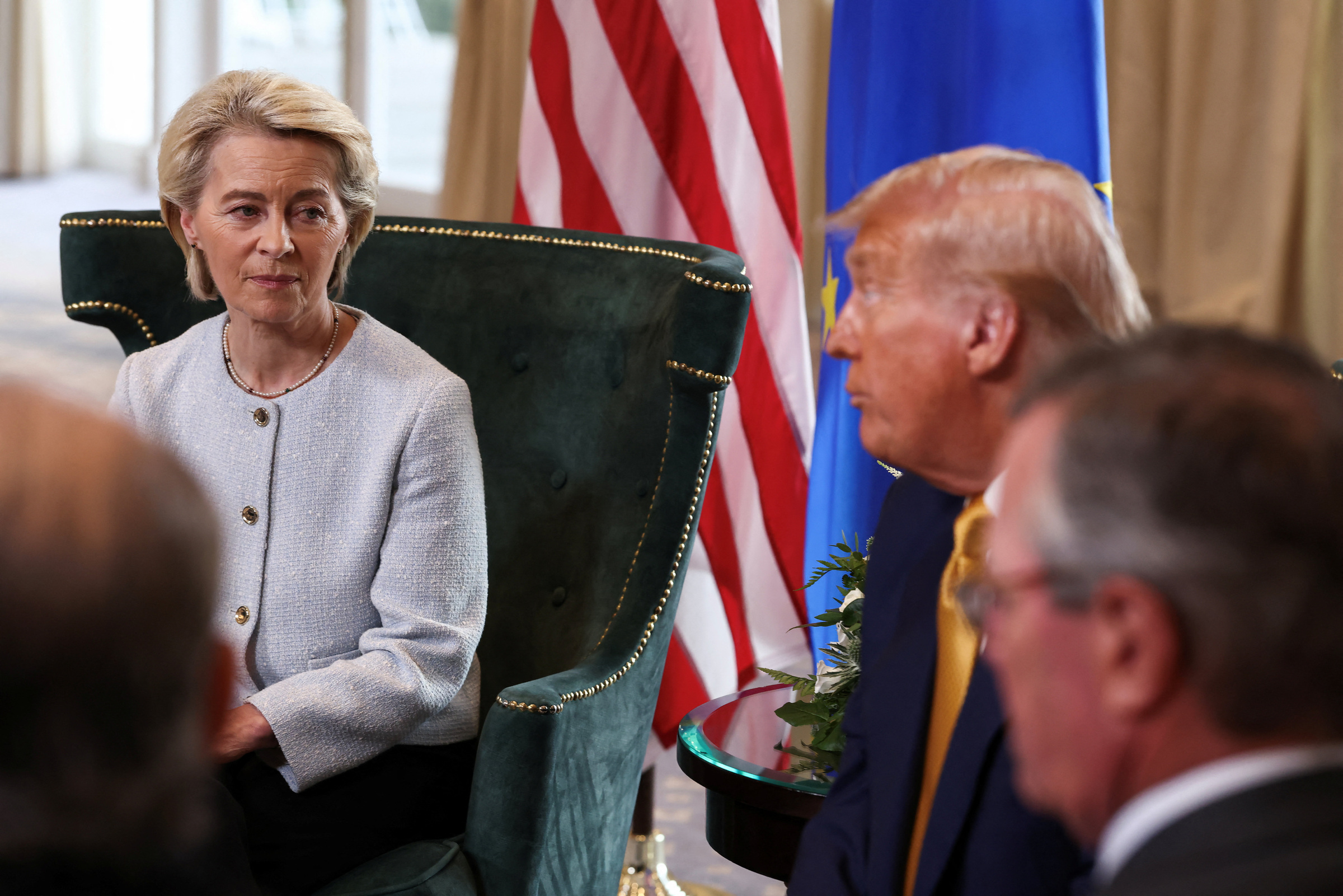On 27/7, the US and the European Union (EU) announced a framework agreement on trade. Analysts believe the two sides have avoided the worst-case scenario – an all-out trade war between the longtime allies, which threatened to raise prices on a range of products and drag down growth in two of the world's leading economies.
The US agreed to reduce import tariffs on most European goods to 15%. This is a 5% increase from the currently applied 10% tariff and significantly higher than the average 1.2% before Trump took office. However, it's considerably lower than the 30% Trump had threatened if no agreement was reached.
"The US and Europe seem to have averted, for now, a mutually self-destructive trade war in the largest, deepest, and most consequential trade and investment relationship in the world," Jörn Fleck, senior director at the Atlantic Council's Europe Center, told CNN.
 |
European Commission (EC) President Ursula von der Leyen and US President Donald Trump in Scotland on 27/7. Photo: Reuters |
European Commission (EC) President Ursula von der Leyen and US President Donald Trump in Scotland on 27/7. Photo: Reuters
The framework agreement offers both sides a sigh of relief. At the end of May, this outcome seemed impossible. Frustrated by the lack of progress, President Trump wrote on Truth Social, "The talks are going nowhere". A day later, he declared in the Oval Office, "I’m not looking for a deal anymore. We’ll make our own deal, with 50% tariffs".
This statement shocked European trade negotiators. EU leaders were forced to act, quickly accelerating the negotiation process. Following a call from European Commission President Ursula von der Leyen with a pledge that the EU would act "quickly and decisively", Trump backed down from his threat and said discussions would continue.
Reuters suggests Europe ultimately acknowledged it didn't have the leverage to secure a trade deal entirely on its terms. Instead, the EU settled for an agreement within its tolerance, but clearly skewed toward the US.
Zero tariffs were agreed upon for some strategic items, including aircraft and aircraft parts, certain chemicals, and pharmaceuticals. However, von der Leyen said no decision had been made on tariffs for wine and spirits. Meanwhile, tariffs on aluminum and steel remain at 50%.
When asked whether the 15% tariff was a good deal for European car manufacturers, von der Leyen replied, "15% is not something to sneeze at, but it's the best we could achieve".
This agreement is particularly noteworthy as Europe has long positioned itself as an export superpower, advocating for rules-based trade, both for its own and global benefit. Analysts see the deal as a cautionary tale for the EU's ambitions to become an economic force that can rival the US and China.
While the trade deal will help Europe avoid a recession, its economy remains constrained. Last month, the European Central Bank (ECB) projected two growth scenarios for this year in the event of tariffs, at rates of only 0.5-0.9%. Without tariffs, the bloc's GDP could grow by over 1%.
Before Trump took office, the average tariff on products entering the US was 1.5%. Even when the UK negotiated a 10% tariff with the US in May, European officials believed they could do better, aiming for 0%. At the time, they believed the EU had the economic strength to stand up to Trump.
"The EU doesn’t have that much more leverage than the US. The Trump administration is in no hurry," a senior European official said. Last week, this official had indicated the new tariff could be around 15%.
Other officials pointed out that Europe was under pressure from exporters within the bloc. The trade uncertainty had begun to affect companies like Finnish telecoms firm Nokia and Swedish steelmaker SSAB.
"We are playing a bad hand of cards. This deal is the best possible in the current situation. Developments in recent months have clearly shown how global trade instability is affecting European businesses," another EU diplomat explained.
The imbalance is also evident in the agreement. In addition to abandoning its plans for retaliation and opening its markets to American goods, Europe agreed to purchase 750 billion USD worth of energy products, invest 600 billion USD in the US, and purchase more US military equipment. The timeframe for these investments has not been disclosed.
During the negotiations, the EU also seemed to realize it would suffer more from a full-blown confrontation. The retaliatory measures the EU had threatened would only apply to about 93 billion euros worth of US goods, less than half of their goods trade surplus with the US.
Some EU member states had supported large-scale retaliatory measures targeting services rather than goods. However, they have not yet reached a consensus on targeting US digital services like Netflix, Uber, or Microsoft's cloud computing, platforms popular with European consumers and lacking viable alternatives within the bloc.
It remains unclear whether the agreement with the US will spur European leaders to accelerate economic reforms and diversify their trade alliances, commitments they have made but not yet implemented due to disagreements among member states.
Dirk Jandura, president of the German Wholesale, Foreign Trade and Services Association (BGA), described the agreement with the US as "a painful concession" and "an existential threat" to many member states. He urged that it was time for Europe to reduce its dependence on its largest trading partner.
"Let the past few months serve as a wake-up call. Europe needs to prepare strategically for the future. We need new trade agreements with the world's leading industrial powers," he concluded.
Ha Thu (according to Reuters, CNN)












